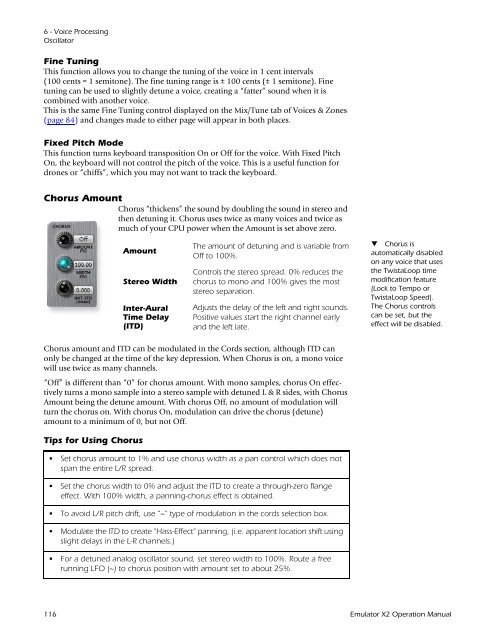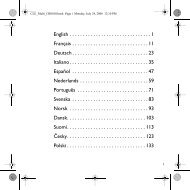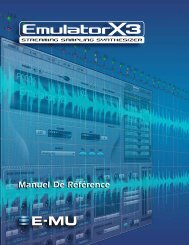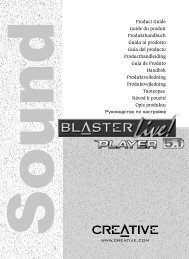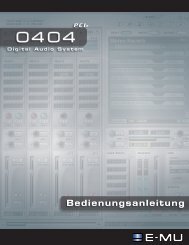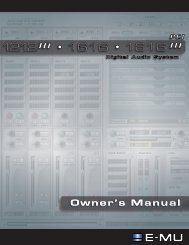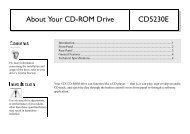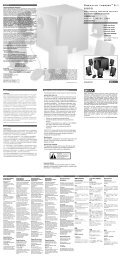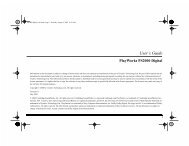Emulator Composite.book - Creative
Emulator Composite.book - Creative
Emulator Composite.book - Creative
You also want an ePaper? Increase the reach of your titles
YUMPU automatically turns print PDFs into web optimized ePapers that Google loves.
6 - Voice Processing<br />
Oscillator<br />
Fine Tuning<br />
This function allows you to change the tuning of the voice in 1 cent intervals<br />
(100 cents = 1 semitone). The fine tuning range is ± 100 cents (± 1 semitone). Fine<br />
tuning can be used to slightly detune a voice, creating a “fatter” sound when it is<br />
combined with another voice.<br />
This is the same Fine Tuning control displayed on the Mix/Tune tab of Voices & Zones<br />
(page 84) and changes made to either page will appear in both places.<br />
Fixed Pitch Mode<br />
This function turns keyboard transposition On or Off for the voice. With Fixed Pitch<br />
On, the keyboard will not control the pitch of the voice. This is a useful function for<br />
drones or “chiffs”, which you may not want to track the keyboard.<br />
Chorus Amount<br />
Chorus “thickens” the sound by doubling the sound in stereo and<br />
then detuning it. Chorus uses twice as many voices and twice as<br />
much of your CPU power when the Amount is set above zero.<br />
Amount<br />
Chorus amount and ITD can be modulated in the Cords section, although ITD can<br />
only be changed at the time of the key depression. When Chorus is on, a mono voice<br />
will use twice as many channels.<br />
“Off” is different than “0” for chorus amount. With mono samples, chorus On effectively<br />
turns a mono sample into a stereo sample with detuned L & R sides, with Chorus<br />
Amount being the detune amount. With chorus Off, no amount of modulation will<br />
turn the chorus on. With chorus On, modulation can drive the chorus (detune)<br />
amount to a minimum of 0, but not Off.<br />
Tips for Using Chorus<br />
Stereo Width<br />
Inter-Aural<br />
Time Delay<br />
(ITD)<br />
The amount of detuning and is variable from<br />
Off to 100%.<br />
Controls the stereo spread. 0% reduces the<br />
chorus to mono and 100% gives the most<br />
stereo separation.<br />
Adjusts the delay of the left and right sounds.<br />
Positive values start the right channel early<br />
and the left late.<br />
Set chorus amount to 1% and use chorus width as a pan control which does not<br />
span the entire L/R spread.<br />
Set the chorus width to 0% and adjust the ITD to create a through-zero flange<br />
effect. With 100% width, a panning-chorus effect is obtained.<br />
To avoid L/R pitch drift, use “~” type of modulation in the cords selection box.<br />
Modulate the ITD to create “Hass-Effect” panning, (i.e. apparent location shift using<br />
slight delays in the L-R channels.)<br />
For a detuned analog oscillator sound, set stereo width to 100%. Route a free<br />
running LFO (~) to chorus position with amount set to about 25%.<br />
Chorus is<br />
automatically disabled<br />
on any voice that uses<br />
the TwistaLoop time<br />
modification feature<br />
(Lock to Tempo or<br />
TwistaLoop Speed).<br />
The Chorus controls<br />
can be set, but the<br />
effect will be disabled.<br />
116 <strong>Emulator</strong> X2 Operation Manual


